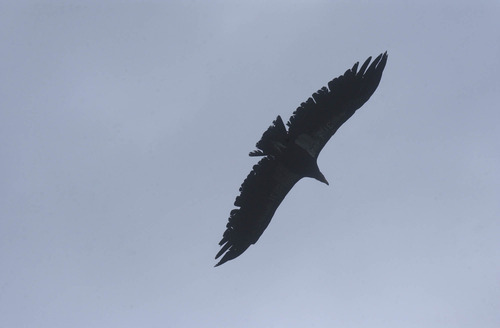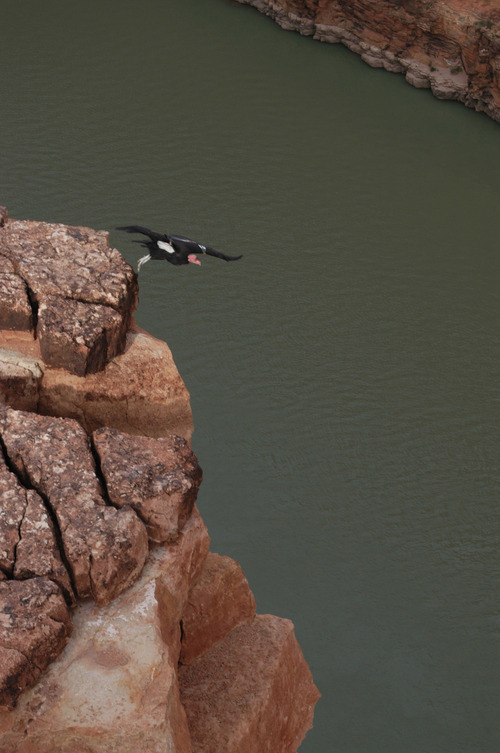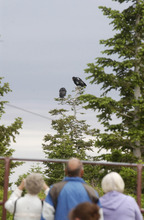This is an archived article that was published on sltrib.com in 2011, and information in the article may be outdated. It is provided only for personal research purposes and may not be reprinted.
Cedar City • The recent deaths of three endangered California condors has prompted Utah wildlife officials to again urge hunters to stop using ammunition that contains lead.
This time of year, the birds are soaring over southern Utah and feasting on a smorgasbord of deer, elk, sheep and cattle that die from natural causes. But they also feed on gut piles left by hunters who dress their kill in the field and leave behind a possibly lethal dose of lead.
After one bird was found dead by a hiker in Grand Canyon National Park in early May, 30 birds were captured at a release site in Vermillion Cliffs National Monument, adjacent to the Utah state line in Arizona, and tested. Six had been poisoned by lead, and two more subsequently died. Three others were treated and released, according to the Peregrine Fund, which has been working since the 1990s to restore the birds in their natural habitat.
Chris Parish, the lead biologist with the Peregrine Fund's recovery program in Arizona, said Wednesday that the poisonings did not occur during hunting season and shows the birds are susceptible at any time.
But hunters aren't the only source of lead pellets, according to Parish. Ranchers or law enforcement personnel may use shells containing lead pellets when euthanizing an animal. A shooter using a dead animal for target practice can pepper a carcass with lead, which can kill other scavengers such as eagles and ravens.
Parish said the dead birds were sent to the San Diego Wild Animal park and Zoo, which determined the birds died from lead poisoning.
X-rays showed 18 shotgun pellets in the digestive system of one bird and 6 in another, he said. The third had remains of a spent bullet in its system, suggesting the scavengers died after eating one or more animal carcasses that had been shot with ammunition containing lead.
Chronic lead poisoning paralyzes a condor's digestive system, which leads to starvation, weakness, and death, Parish said. Acute lead poisoning, typical at high doses, can kill condors more quickly.
Parish said lead wasn't known as a cause of condor deaths until the birds were released in the wild beginning in 1996. "We did not even consider [lead] as a problem in the beginning."
Parish said the dead condor found by the hiker was an 11-year-old male. That was considered especially bad news because the birds don't even sexually mature until age 8 and can live in the wild for 60 years. Condors lay only a single egg in a year.
Parish encouraged hunters in Utah and northern Arizona to use ammunition made with copper through a voluntary program offered in certain hunting areas in both states.
Mark Hadley, spokesman for the Utah Division of Wildlife Resources, said that hunters who purchase ammunition made with copper can get a rebate of $25 if they submit a voucher to the DWR. Hunters in areas of Washington and Kane counties, where the condors are most concentrated in Utah, are eligible for the rebate, which was launched last year.
Chandler Bates, business development manager for Barnes Bullets, which manufactures ammunition made with copper at its Mona plant in Juab County, said copper is superior to lead for hunting although it costs more.
A box of 20 copper shells can cost around $45, compared to $25 for lead. With the rebate, a hunter in Utah can purchase the copper shells for only $20.
Byron Bateman, president of Sportsmen for Fish and Wildlife, said members of his conservation group have been "overwhelmingly supportive" of the ammunition rebate program in Utah and Arizona.
But a lawsuit filed in April by the Center for Biological Diversity and other conservation groups against the Environmental Protection Agency seeks to ban the use of lead in ammunition, and even fishing tackle.
Adam Keats, a lawyer and spokesman for the San Francisco-based group, said the suit was necessary because voluntary rebate programs like those in Utah and Arizona, which has a 90 percent success rate, don't go far enough. The only way to save the birds is by banning all lead ammunition, he said.
Keats compared the problem to gasoline that contained lead, which was eventually outlawed.
"Using gas [with lead] was not a voluntary program," said Keats. "People had to switch to lead-free and like it. Voluntary efforts don't work. People need stronger incentives."
Watch the birdies
O On June 18, the Utah Division of Wildlife Resources and National Park Service will host a public viewing of wild condors on Kolob Reservoir Road, 21 miles north of the town of Virgin in Washington County. For more info, go to wildlife.utah.gov/dwr.
Condor facts
Prior to reintroduction, the last wild condor was sighted in Arizona just south of the Grand Canyon in 1924.
The condor is the largest flying land bird in North America. The birds can weigh up to 26 pounds and have a wingspan up to 9½ feet.
Condors were added to the federal Endangered Species List in 1967. Today, 68 birds exist in the wild in southern Utah, Arizona, California and northern Mexico.
Source: Peregrine Fund







